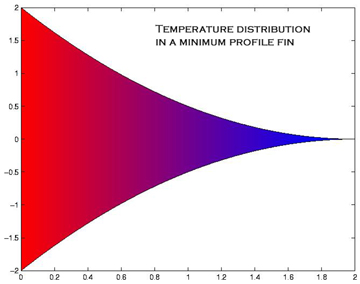
by
Mark Covington
Spring 2001
This project will analyze several different aspects of cooling fins. Above are pictures of three different types of fin profiles. You will notice the color gradient in each is not the same, the colors show the relative temperature distribution in each of the fins. Further discussion of how these were generated can be found below. This project was strongly guided by work from Max Jakob's book Heat Transfer, published posthumously in 1949 by John Wiley & Sons Inc.
Ingenhouss in 1789 was the first to do work with thermal conductivity. We made several rods of the same size and shape out of several different types of materials. Then each of these rods was covered in a thin layer of wax over the rod. Then each of these rods was placed next to a large vessel which was filled with hot water or oil. Then as the bar heated and a temperature profile was established he saw how far the wax melted off of the rods. The rods that had a greater length of wax melting off conducted greater amounts of heat. Thus, an order of the conductivities of different materials was found.
Variables Used in the following pages.
General Equation for a Heated Rod
Temperature Distribution in a Rod Connecting Two Heat Sources
Heat Loss of a Not Very Long Rod Protruding from a Heat Source
Heat Loss for a Rod with two Heat Sources
The Cooling fin which requires the least material
The Straight Fin of Rectangular Profile
The Straight Fin of Triangular Profile
Comparison of the Three Types of fins.
for questions or comments please contact the Ceng 402 professor Dr. S.H. Davis or the creator of the web page Mark Covington